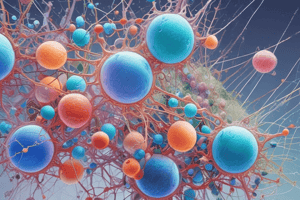Podcast
Questions and Answers
Which of the following is NOT a function of extracellular structural elements?
Which of the following is NOT a function of extracellular structural elements?
- Storing fat and minerals
- Facilitating energy production (correct)
- Providing mechanical stability
- Connecting organs and tissues
Bilateral symmetry means that parts on opposite sides of a median plane are similar in shape and size.
Bilateral symmetry means that parts on opposite sides of a median plane are similar in shape and size.
True (A)
Name one determinant of multicellular body plans.
Name one determinant of multicellular body plans.
Symmetry
A type of symmetry where body parts are arranged around a central axis is called __________ symmetry.
A type of symmetry where body parts are arranged around a central axis is called __________ symmetry.
What is the primary tissue type responsible for transmitting signals in the animal body?
What is the primary tissue type responsible for transmitting signals in the animal body?
Match the types of symmetry with their descriptions:
Match the types of symmetry with their descriptions:
In animals, extracellular structural elements are primarily found within the cells.
In animals, extracellular structural elements are primarily found within the cells.
Name one of the two major fluid compartments in animal bodies.
Name one of the two major fluid compartments in animal bodies.
The type of symmetry characterized by having a top and a bottom but no distinct left and right is called __________ symmetry.
The type of symmetry characterized by having a top and a bottom but no distinct left and right is called __________ symmetry.
Match the following types of symmetry with their definitions:
Match the following types of symmetry with their definitions:
Flashcards are hidden until you start studying
Study Notes
Extracellular Structural Elements
- Composed of connective tissue, cartilage, and bone, providing mechanical stability and protection.
- Acts as a depot for materials, facilitating exchanges and serving as a medium for extracellular reactions.
- Supports organs and the body through frameworks, connection, binding, and storage functions.
- Reduces friction, especially where flexibility is necessary, notably in bony areas.
- Ensures protection of internal organs while storing minerals and forming new blood cells.
Determinants of Multicellular Body Plans
- Four primary determinants: symmetry, presence/absence of body cavity, segmentation, and cephalization.
Animal Symmetry
- Symmetry refers to balanced proportions of parts on opposite sides of a median plane, crucial in predator-prey dynamics.
- Predators tend to be larger than their prey, improving mobility and energy efficiency.
- Larger size enhances homeostasis, enabling better internal environmental regulation.
Components of the Multicellular Animal Body
- Comprised of three key elements: cells, body fluids, and extracellular structural elements.
- Functionally specialized cells differentiate into tissues responsible for specific functions.
Major Tissue Types
- Basic tissue types include nervous, connective, epithelial, and muscular tissues.
- Tissues aggregate to form organs, which work together within systems.
Body Fluids
- Fluids permeate all body tissues and spaces, organized into two major compartments: intracellular and extracellular.
- Intracellular space: 70% water, contains smaller molecules, ions, proteins, and organelles.
- Extracellular space: Comprised of blood plasma (90% water, 10% ions, proteins, and nutrients) and tissue fluid (sugar, hormones, O2, CO2, water, fatty acids, salt).
Cellular Organization
- Aggregation of functionally differentiated cells shows clear division of labor among cells, dedicated to specific functions like reproduction and nutrition.
Protoplasmic Structures
- Nucleus: Contains nuclear membrane, nucleoplasm, nuclear pores, nucleolus, and genetic materials.
- Cytoplasm: Composed of organelles including rough and smooth endoplasmic reticulum, Golgi apparatus, lysosomes, vacuoles, mitochondria, ribosomes, cytoskeleton, and centrioles.
- Cell Membrane: Structure includes a phospholipid bilayer with peripheral and integral proteins.
Tissue Level of Organization
- Aggregation of similar cells forms tissues; for example, cnidarians have a nerve net for coordination.
Organ Level of Organization
- Tissues aggregate into organs, which consist of multiple tissue types and perform specialized functions, such as eyespots and reproductive organs in flatworms.
Organ System Level of Organization
- Highest organizational level whereby organs collaborate for complex functions, exemplified by systems like the digestive and circulatory systems first seen in nemertean worms.
- Complexity increases with body size due to specialization and labor division, offering advantages such as improved survival and efficiency.
Studying That Suits You
Use AI to generate personalized quizzes and flashcards to suit your learning preferences.




